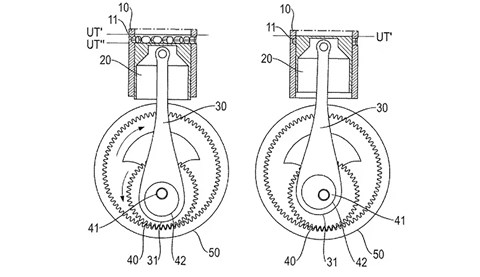► Porsche engine tech
► New 4 + 2-stroke format
► Examining recent Porsche patents
Porsche has filed patents for an engine cycle with two combustion events for every six strokes (or three rotations of the crankshaft). They call it a 2 x 3-stroke. I’d humbly suggest it’s a 4 + 2-stroke.
The conventional four-stroke cycle has phases comprising induction, compression, expansion, and exhaust (with combustion occurring just before expansion). The new cycle drops a two-stroke event in, enabled by a pretty complex crankshaft arrangement that allows two different top and bottom dead centre positions during the same cycle. It now includes second compression and expansion events after the first expansion phase: the two-stroke bit. Except it’s even more complex than that…
In its patent illustrations, Porsche has shown a ‘scavenging’ phase between the first expansion and second compression as the unusual crankshaft arrangement comes into play. This mechanism allows the piston to reach a ‘lower’ BDC than for the four-stroke bits of the cycle and, in so doing, uncover a belt of scavenge ports that have been lurking just out of sight.

In this sense, ‘scavenging’ is a two-stroke term. Just before those ports are uncovered, the exhaust valves open, allowing some combusted gases to escape and dropping the pressure in the cylinder. When the piston opens the ports, pressurised air blows the gases upwards and through the exhaust – we call this ‘uniflow scavenging’. The exhaust valves and scavenge ports then close and the second compression occurs with ignition at TDC.
This second combustion event is key. It may be that it is not about increasing power but reducing emissions by re-burning gases trapped within the cylinder. Two-strokes lend themselves to ‘homogeneous charge compression ignition’ combustion, which is efficient and clean, with no spark or flame in the normal sense. While some exhaust gases would be lost during the first exhaust event, most could be trapped and re-burned. However, you cannot allow fresh air to exit the exhaust or a simple after-treatment system won’t work, so this would limit power.
I’ve no doubt the Porsche concept could be made to work. But really, why would you want to try? Because there are some disadvantages…
Apart from the mechanical complexity of the crankshaft (with its hypo-cycloidal gearing – think a big Spirograph set), piston-controlled ports require effort to overcome potential ring wear, but I am sure it can be done (big marine two-strokes are uniflow-scavenge engines and are supremely reliable). Generally, with piston-controlled ports, eliminating oil consumption also requires effort. As I’ve said, not all of the gases will get re-combusted and you’ll also need boost pressure for scavenging. Plus, the camshafts now need to turn at one-third engine speed, with the exhaust valves opening twice.
But why not simplify things and just build a uniflow-scavenged two-stroke? Yes, the car industry has severe prejudice against two-strokes. But this six-stroke is at least a third of the way there, and way more complex…